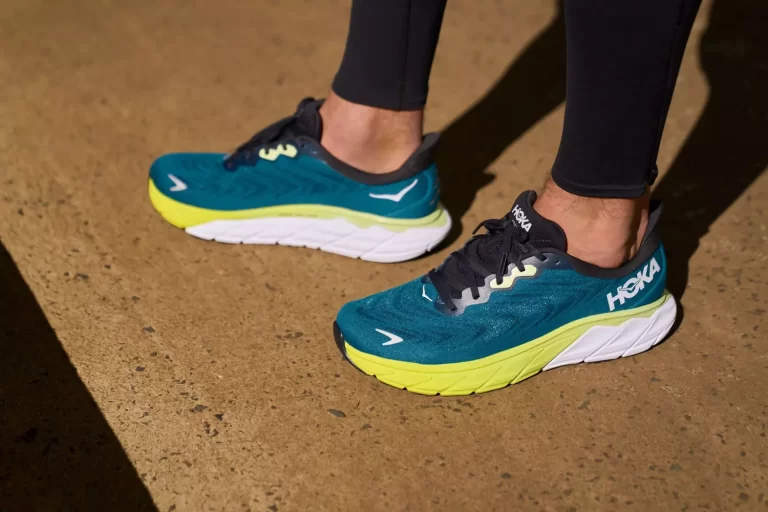The Best Tennis Ball Machines in 2024
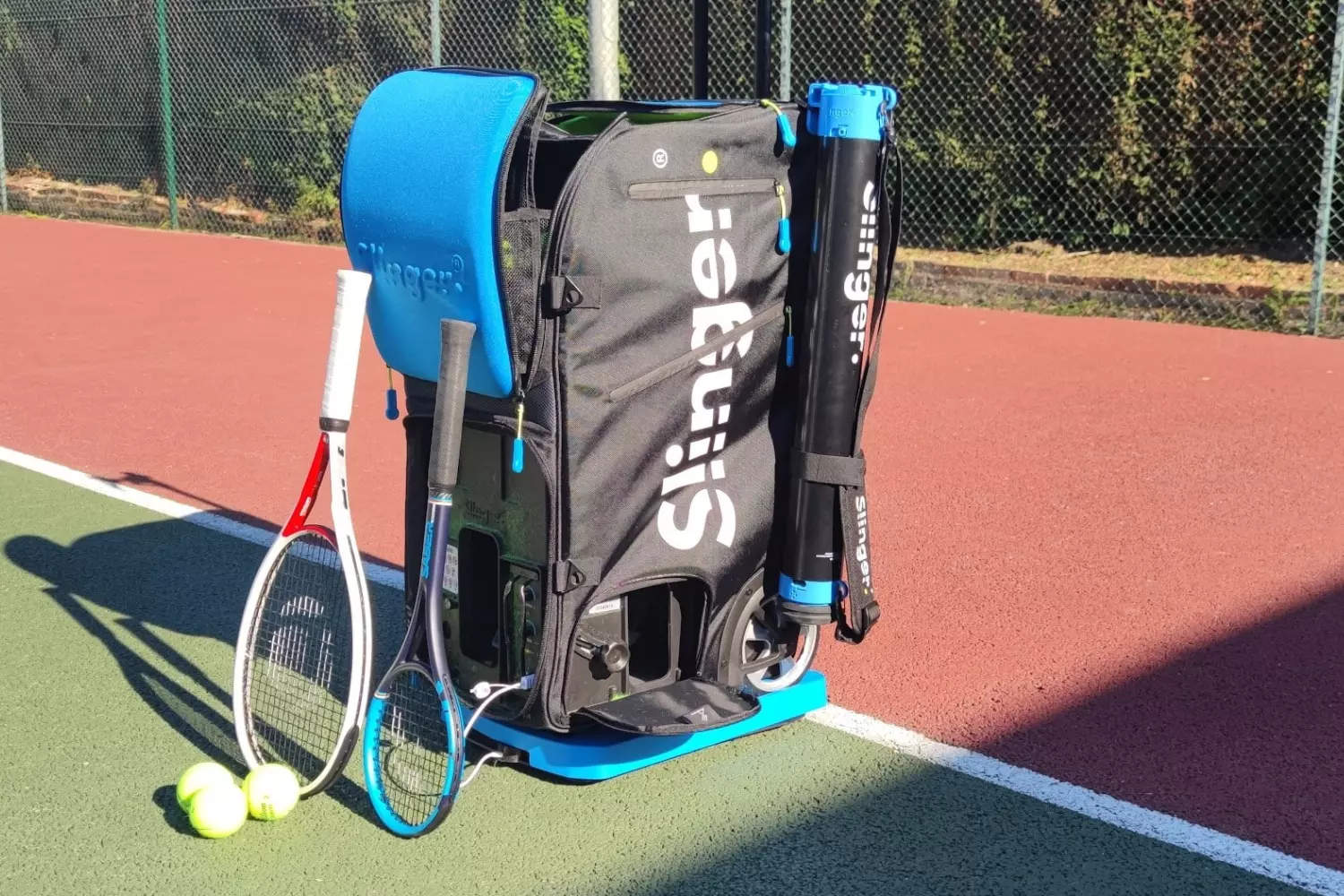
Ball machines can be a great investment for tennis players of any age or skill level looking to improve their game or exercise while playing their favorite sport. But they’re not for everyone.
You should also do your research, compare models, and understand the nuances that differentiate the new models from the older ones. Due to the cost of the best tennis ball machines, it is important to do your research.
You’ll learn how to decide whether ball machines are a good fit, learn how to compare different brands and see what I recommend.
I have compiled a list of seven of the best ball machines you can find online – read on to find out more.
Top Rated Best Tennis Ball Machines 2024
The best ball machine is usually the most expensive and has the most features, but that’s not always the case. My experience, however, suggests otherwise.
It is my experience that the best ball machines combine excellent value, practical features, ease of use, and reliability. As a result, I’ve put together my top picks.
My top five picks for best tennis ball machines are listed below. There are strengths and weaknesses to each brand.
The vast majority of players will enjoy all of these machines, no matter which one you choose.
Spinshot-Player Tennis Ball Machine

Tennis players who want a fully customizable experience should consider this portable tennis ball machine. In terms of tennis ball machines, this machine checks all the boxes.
There are over 120 balls that can be loaded into the machine, and the machine can feed balls at speeds between 19 and 68 mph (30 to 110 km/h). Programmable drills can rotate you from one side of the court to another. The ball machine can feed every 2 to 10 seconds if you need to practice fast-paced volleys.
Its mobile app is, however, its best feature. Easily customize drills for areas of your game that need improvement by downloading it directly from your phone. Each drill can consist of up to six shots and you can create as many drills as you want.
Coaches are right there on the court, but now they are better! This machine will serve as your coach instead of expensive private lessons and will pay for itself in 25 hitting sessions rather than 60 MPH topspin from your coach.
Spinshot Pro Tennis Ball Machine
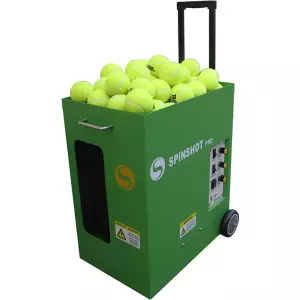
This tennis ball machine is perfect for those who need a physical workout without needing all the customization of advanced machines. The machine has the ability to hit you with a variety of shots, allowing you to get an excellent cardio workout.
If just practicing more is all you need, but you don’t necessarily need a customizable drill experience, this ball machine is a great option for beginners, intermediates, and advanced players. It provides multiple speed and spin options, good battery life, and a compact design. Kids and junior tennis players also benefit from these features.
You can practice backhands and forehands with the oscillation by feeding balls side to side. Change the settings on the control panel to work on approach shots or lobs.
Lobster Sports Elite 1 Portable Ball Machine
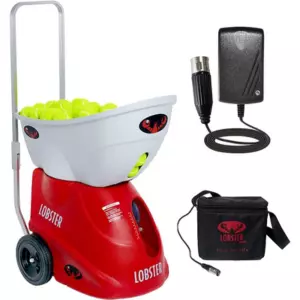
A tennis ball machine like Lobster Elite 1 can provide a great baseline workout, similar to Spinshot Pro. Random oscillations feed balls from side to side, so you can work on both forehands and backhands.
There are some advantages to this machine over the Spinshot Pro, as well as some drawbacks. With a larger ball capacity and faster ball feed than the Spinshot Pro, Lobster Sports’ tennis ball machines all have a larger ball capacity. There is no remote control on this machine, and it is a bit bulkier than the Spinshot Pro.
The machine is great if you don’t want all the drill customization you can get with some higher-end machines. If you improve your skills, you’ll be able to hit plenty of balls.
Tennis Tutor ProLite Ball Machine
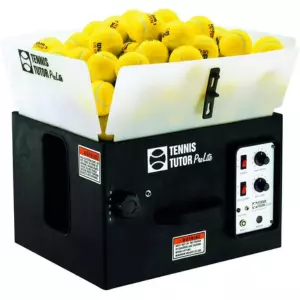
You can’t go wrong with this tennis ball machine if you’re looking for one under $1000. The machine weighs only 29 pounds, making it very portable. Although you cannot create drills with the ball machine, you can practice forehands and backhands with the horizontal oscillation feature.
The feed rate can be adjusted to as low as 1.5 seconds to accommodate most skill levels. Manually adjusting the elevation will allow you to practice groundstrokes, volleys, or even overheads.
Topspin and backspin adjustments are not available on this machine, and it feeds a maximum of 60 MPH. However, under USTA 5.0, this is a fast enough speed for the majority of players.
Spinfire Pro 2 v2

In terms of features, Spinfire Pro 2 v2 is a very good ball machine that offers practically all players would want at a competitive price.
This machine has a variety of feed rates and speed settings, in addition to oscillation and backspin.
As for oscillation, I prefer it over external oscillation offered by some other popular models – it’s whisper quiet, and its feed comes at a slower pace, which keeps you on your toes.
They also have an excellent remote control. In addition to having one of the smallest and lightest designs on the market, it gives you full control over all the machine’s functions, including an automatic sleep function to prevent accidental feeds while picking up balls.
Their money-back guarantee is the most generous of any machine. In order to initiate a refund, you must contact us by the 30th day after delivery, and we will ship your order within five business days.
LOBSTER Sports Elite Three Tennis Ball Machine
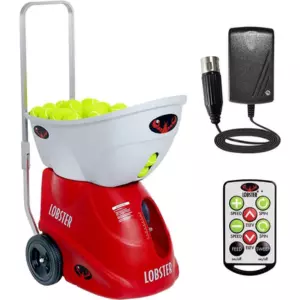
It is a great option from a highly reputable brand – perhaps one of the most well-known due to its extensive product line.
This high-quality ball machine comes with virtually everything you could ask for. I think it has the essentials, but it isn’t overstuffed with features.
These are some reasons why you might prefer the Lobster Elite Three to the Spinfire Pro 2:
- Although the Spinfire Pro 2 includes a pricey remote, you will save a few hundred dollars regardless.
- There is an app-based remote that can be used if that’s something that interests you. It isn’t better than the Spinfire, though they sell a separate lightweight remote I can carry in my pocket. The Spinfire Remote works better on this machine. Lobster’s best remote is in their Grand line.
- It should be lightweight and have a battery. It weighs 42 lbs (19 kg) with a battery, versus 40 lbs (18 kg) with an external battery for Spinfire Pro 2. You can choose an internal battery from Spinfire, which weighs 53 lbs (24 kg).
Consider the Spinfire instead for these reasons:
- Internal oscillation hides the ball’s feed direction and is also quieter.
- The best remote for your budget is what you are looking for. It is important to note that Lobster’s Elite Grand remote is similar to Spinfire’s, but you will have to spend more on their Elite Grand machine, as well as their Grand machine’s remote.
- A money-back guarantee with the highest level of protection is what you need. It takes 30 days for Lobster to receive your machine, but Spinfire only requires that you notify them within 30 days, which gives you 5 days to ship.
Each machine has a different handle for wheeling, and its styling differs. It’s worth considering both options.
Lobster’s variety of machines and price points are also worth noting. For a lower-end model, try the Lobster Elite Two or one of their other lower-end models if the Lobster Elite Three is too expensive for you.
If, however, you are looking for more features, such as drills, you can always upgrade to a Grand model.
Lobster Sports Portable Ball Machine
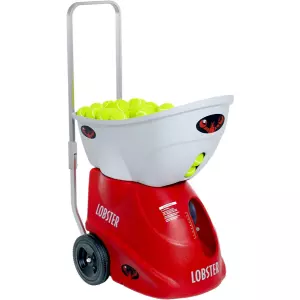
This tennis ball machine is great for improving your fitness for singles or hitting a lot of balls. Balls can be fed at different speeds, spins, and elevations by this ball machine.
A high-level tennis player can use this machine to hit balls at speeds up to 80 miles per hour because of its large ball capacity and high-speed capability. Starting at 10 MPH is enough for beginners. There is a top-of-the-line feed frequency, oscillation, and elevation.
Balls are oscillated vertically, horizontally, or both by this machine. The court is divided into two halves, so you can practice groundstrokes and approach shots from either side. You can then choose whether the ball machine works on the forehand or backhand. It’s a great workout if you set both the vertical and horizontal movements to random.
With this machine, drills cannot be customized. The random setting can be turned off if you are working on one shot in repetition. You will also have to pay extra for the remote control.
Spinshot Plus 2
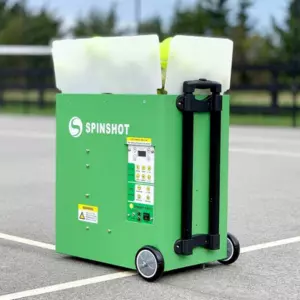
As one of the best tennis ball machines, the Spinshot Plus 2 is another fantastic machine.
With its Drill Maker App, this machine introduces programmable drills at nearly the same price point as the Spinfire Pro 2 and Lobster Elite Three.
In our list of the best overall ball machines, the Spinshot Plus 2 might interest you since it weighs in at only 37 lbs (17 kg) with an internal battery. A smaller footprint or dimensions may also make the machine more convenient to store or transport. As a final note, it boasts a powder-coated metal construction.
Lobster Elite Three and Spinfire Pro 2 have smaller ball capacities of 120, 68 mph (109 kph), and 80 mph (129 kph), respectively. Most importantly, their battery life is shorter at 2-3 hours.
Sports Tutor Tennis Tutor Plus Player
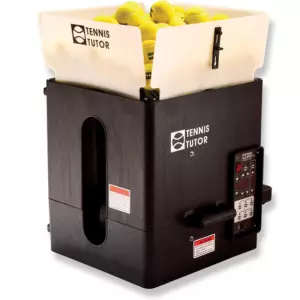
The next product on the list is the Tennis Tutor Plus Player from Sports Tutor. Almost all of the functionality discussed before is included in this ball machine, as with the previous three.
There is one feature that separates it from others: the ability to feed balls at speeds of 10-85 mph (16-137 kph). This machine also has a faster feed rate, maxing out at 1.5 seconds vs. 2 seconds for the others.
The heaviest and most expensive of the bunch, however. It is possible to purchase an external battery, but it will cost you extra on top of the already pricey machine. Additionally, it offers only a one-week money-back guarantee.
Personal preference will certainly play a role in your decision since we’re talking about small differences between these machines.
Wilson Ball Machine

The Wilson tennis ball machine, built by Sports Tutor, comes last on our list of the best tennis ball machines overall.
A low price point and a series of essential features make it another great option, even if it’s not the most capable machine in the group.
Another bonus is its lightweight nature and compact size, which is just as convenient as the Spinshot Plus 2.
Slinger Bag
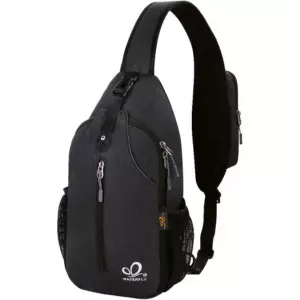
When you don’t want to spend several thousand dollars on a ball machine, a Slinger Bag makes a great alternative. You can use it as both a bag and an affordable backpack.
It won’t cost you more than a thousand dollars to buy their most expensive bundle, which includes tennis balls. Because of this, it’s definitely an excellent ball machine for kids.
For clarity, I would not compare it to the five other models on our best-of list, since they are simply on a different level, at a higher price point.
Tennis Twist
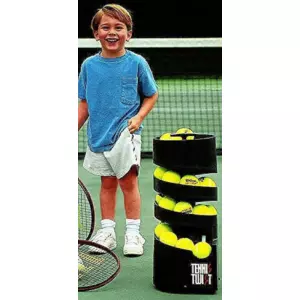
The Tennis Twist ball machine from Sports Tutor is an excellent choice if you’re a parent looking for simple ball entertainment for your child.
Your child will enjoy using it on and off the court since it’s extremely easy to operate. Kids love loading it because of its spiral design, and it holds up to 28 balls. In addition, it is easy to operate.
The ball will be fired every five seconds from a distance of 12 to 20 feet as soon as you flip the switch on. On the machine’s bottom, there is a ring you can pull to control the distance.
As parents, it’s worth considering despite its high price point given what it offers.
Why Buy a Tennis Ball Machine?

A ball machine is an investment, but the more you use it, the more value you’ll get out of it, which can be anywhere from a few hundred dollars to several thousand.
Below you will find a few of the most common reasons why purchasing one can be a good choice for you or your family, along with some thoughts to consider.
Limited Access to Hitting Partners
It’s a common one I hear all the time. People might not be as accessible in a less populated area if you live there.
Having trouble finding players of similar skill levels might be due to a lack of popularity of tennis near you.
Tennis ball machines are logically a solution to this frustrating challenge.
If you are interested in playing the game for social reasons, I urge you to consider how important the social component is to you. Certainly, a ball machine won’t replace the social connection tennis offers.
Targeted Practice
Tennis is no different, practice is an essential part of any learning process.
The student is responsible for taking what they’re taught and applying it through practice if they expect to improve, even when beginning with instruction.
Ball machines are ideal for this purpose because they allow a player to repeat a specific shot repeatedly, building muscle memory and improving confidence.
As a result, if you intend to buy a ball machine for this reason, I suggest renting one first before making a purchase.
The idea of hitting the same stroke repeatedly might seem ideal at first glance. The repetition may seem tedious to some players, so it’s a useful experiment to understand your feelings after hitting 50 or 100 forehands.
Furthermore, players looking for repetition should ensure that their ball machine can hold enough balls so that they can repeat without stopping and picking up too often.
An Enjoyable Form of Exercise
It might be fun to stay active while doing something you love with a ball machine, if you don’t like running, hitting the gym, or riding a bike around the neighborhood.
To help you maintain the habit, I would suggest considering portability and convenience. It will be easy to fall out of the habit if your machine is heavy and hard to transport, or if you don’t have tennis courts nearby.
It would also be a good idea to rent a ball machine before purchasing one if possible in order to ensure you enjoy the workout. Playing tennis is fun for many people, but removing another person’s unpredictable play on the other side of the court reduces its fun, so you should give it a try.
Supplement Lessons
Ball machines can also be used as a supplement to group and private lessons. Lessons are extremely beneficial, however, most of the time is spent drilling with the instructor or other students.
Ball machines, particularly in group lessons, can assist students who may not get to hit nearly as many balls as they’d like due to class size.
It may even be possible for you to save and help pay for the machine depending on your lesson schedule. It costs $50 per lesson, so you could save $100 per month if you took t lessons once a week.
Teaching Tool
Finally, ball machines can be a great teaching tool for tennis instructors.
The instructors will normally feed their students from the other side of the net, which is entirely sufficient. It is necessary to stop and meet at the net or run over to the other side of the court, if they wish to provide some feedback, such as showing or helping a player through a specific movement.
An instructor doesn’t have anyone to feed them the ball when they want to demonstrate a shot, movement, or pattern. While a ball machine isn’t absolutely necessary, it can be a useful teaching tool. It can also be used as a rental and pay for itself over time.
You can also read How Many Rounds Are In The US Open?
Lessons vs. Ball Machines

The vast number of online learning resources available has led me to ask several times if players should take lessons or buy a ball machine and learn themselves.
The first recommendation I always give to players is to take lessons, so that they can start with a solid foundation, then consider a ball machine after some time.
The reasons are several. Having an instructor who can correct a player in real time is a great way to better understand tennis’ many nuances. Consequently, players will learn faster with an instructor.
My second observation is that many players get excited about tennis initially but don’t enjoy it as much as they expected. After spending thousands of dollars on a ball machine, finding out someone has moved on would not be pleasant.
Lastly, many players enjoy tennis for its social interaction and competition as well as its play, which helps them stick with it.
Thus, I recommend playing lessons first and only purchasing a ball machine when players are confident in their dedication.
New vs. Used
A used ball machine might be a good option if you want to save some money on a ball machine purchase.
Many of these apps have appeared in recent years for selling goods, such as Craigslist, eBay and Facebook Marketplace.
A useful tip is that Sports Tutor sells reconditioned used and demo machines directly on their website, so if you’re looking for a deal, make sure you check them out.
Due to the fact that ball machines don’t receive massive regular upgrades or overhauls, they generally hold their value pretty well. Even so, it won’t be easy to find a substantial discount unless you’re patient to wait or a risk taker.
Furthermore, people don’t tend to throw away some of the best ball machines from reputable brands. That said, you shouldn’t rule out trying it out to see if you can save yourself a little money before investing in a new one.
The following points should be kept in mind if you plan to buy a used machine. First off, it’s unlikely that you’ll be able to transfer the warranty since it usually applies to the original owner only.
Additionally, ball machines are usually long-lasting equipment when properly cared for, but they do age and require maintenance over time. In most cases, the battery will wear out first, lasting between 2-3 years.
Apart from that, replacement parts are usually relatively easy to find with most reputable brands, so if you’re handy, you shouldn’t have any problems. If peace of mind is important to you, then you might not want to go used without a warranty.
Lastly, make sure you watch the machine feed on a tennis court before you buy it. Though the device might turn on and fire up without issue, you should not buy it until the owner shows that it works as expected.
Features to Consider When Choosing A Ball Machine

Generally, the cost of ball machines depends on the machine’s capabilities and features.
Some of the more expensive tennis ball machines are overkill for most tennis players, even if they offer all the bells and whistles.
Here are some of the most common features you’ll find with ball machines, accompanied by some thoughts and context on each.
Power options in Ball Machines
A few ball machines are electric, powered by a direct connection to an outlet, or battery-powered.
Battery Powered
Generally, I believe that players who want a personal ball machine will benefit most from battery-powered machines, which can easily be transported wherever you want. The majority of these are battery-powered, thanks to manufacturers who recognize this.
With most tennis ball machines, which have large batteries, you can expect to play for between 2 and 8 hours.
If you’re actively using oscillation features if the machine allows it, the length of play will largely depend on how consistently you run the machine.
I have found that most battery-powered games provide more than enough playtime for one person. Multiple family members using it on a daily basis could make it a factor.
As well as considering how long a battery can last, you will also want to consider how fast it can charge.
A speed charger should be able to charge a battery to full within 3-4 hours instead of 8-12 hours using a standard charger.
As long as I charge my machine right after I get home, I have never had an issue with a standard charger. Most people will agree with that.
Moreover, smart charging allows you to stop charging a battery once it’s fully charged, thus preserving the battery. Once upon a time, this was a competitive advantage, but now everything offers this.
Lastly, batteries tend to last between 3-4 years and will eventually need to be replaced. Charge your battery regularly and use your machine regularly to extend its life. The cost of a new battery is $100 – $200, so that should be noted.
You can also read How To Play Tennis On A Budget?
Electrical Outlet AC Power
An AC electric ball machine can be used by clubs or instructors if the machine is continuously used. However, battery-powered machines remain viable, and instructors and clubs can always purchase additional batteries.
Capacity
There is a maximum number of tennis balls that a tennis ball machine can hold before refilling with new balls.
The number of balls a ball machine can hold is a matter of personal preference, but I recommend looking for one that has a minimum capacity of 50 balls, which serves two purposes.
In the first place, picking up balls constantly zaps the fun factor pretty quickly. Secondly, you need 50 balls in order to establish a rhythm you can repeat when you practice.
There are some players who will feel that 50 balls is a lot, but it will give you the opportunity to grow into the machine, which you’ll likely appreciate as you progress. The ball machine is also best used by you and a friend or family member. A higher capacity might be a good idea if you want to hit together, but you can always alternate and take turns collecting balls.
Additionally, a large quantity of tennis balls for your machine can be expensive to purchase in bulk. You might find it appealing to hit 150 balls, but once you have to purchase balls for the machine, the appeal goes down.
As a result, I find that most players need a 150-ball capacity max, with many players only filling half of it.
Feed rate or Interval
It is the interval between firing each ball from the machine that determines the feed rate or interval.
It makes the experience more challenging or engaging if the feed rate or interval is lower.
Less experienced players benefit from higher feed rates or intervals because they can take longer between shots.
It is more than enough for most players to be able to adjust feeding rates between 2-10 seconds on most tennis ball machines.
Oscillation
Rather than feeding balls to one spot in the court, oscillation refers to a machine’s ability to move the balls around the court at different locations. Tennis ball machines oscillate in three ways:
- Horizontal random: Tennis balls can be fired from side to side at random locations while maintaining the same depth for each ball, which is great for practicing ground strokes and volleys.
- Vertical random: Tennis balls can be fired from the machine at random, just as they would be fired from an opponent in a match.
- 2-line: Throwing balls at random can make practice more realistic. It is possible for players to want a more consistent feed, so you can use the 2-line function. A wide, medium, or narrow feed width may be specified on machines with 2-line feeding.
Tennis balls can be thrown at random locations throughout the court using horizontal and vertical random oscillation machines. Triple oscillation refers to the combination of these settings for a third option, which can be found in some scenarios.
A genuinely useful feature of oscillation is its ability to add variety to the hitting experience. As a result, you do not have to manually adjust the machine for different shot locations.
External vs. Internal Oscillation
The oscillation may be external or internal depending on the machine.
It is visible at the bottom of an external oscillation machine that a mechanism moves the entire device back and forth. An internal oscillating machine, on the other hand, moves its parts internally. One should be considered over the other for two reasons.
Firstly, external oscillation makes it easier to see where the next ball will be fed because the machine points in that direction beforehand. The machine stays still instead of oscillating internally, which helps conceal where the next ball will be fired.
The second reason is that machines with external oscillation may be noisier due to the outside location of the mechanism.
The quieter the machine, the better if you’re planning on playing on public courts.
Drills
For practicing specific strategies or simulating match play, drills are typically a feature of higher-end machines.
Drills may change the ball’s location, spin, speed, and height depending on the machine.
- Pre-programmed: Players can use pre-programmed drills to keep their training varied while also replicating real-life scenarios or playing styles.
- Programmable: The sequence of shots fed by a programmable drill can be customized. Depending on the machine, a player may be able to choose from a variety of shot selection options, such as spin, speed, and height.
- The number of shots: Most tennis ball machines allow you to set the number of balls to be fed per programmed drill as well as the maximum number of shots to take.
Generally, I consider most drill features overkill relative to additional cost in most cases. The added variety is appreciated by many players, however, so it is something you should weigh carefully.
Hopper Window
In some ball machines, you can find slots or a window at the front of the hopper, which indicates how many balls are left before you need to pick them up.
Several companies have embraced semitransparent hopper windows to make it easier to see how many balls remain.
Ball Speed
You may choose to increase or decrease the difficulty level by speeding up or slowing down the ball.
A typical machine offers speeds between 10-95 mph (16-153 kph), while the majority offer speeds between 10-65 mph (16-105 kph). Most players will be fine with ball machines that feed up to 65 mph (105 kph); however, if you need a machine that feeds faster, you can find plenty of them.
Low-end speeds are useful for parents who are evaluating ball machines for their children. The majority of machines offer speeds as low as 10mph. However, some popular models offer speeds between 18 and 35mph.
Spin
Many ball machines nowadays offer both topspin and backspin, but some still only offer topspin.
Moreover, some allow spin to be enabled but not the level or strength of it.
For beginners, spinning is a pretty important part of simulating the most realistic hitting experience, but it’s not a requirement.
You can also read How Tall Are Tennis Players?
How to Choose a Ball Machine
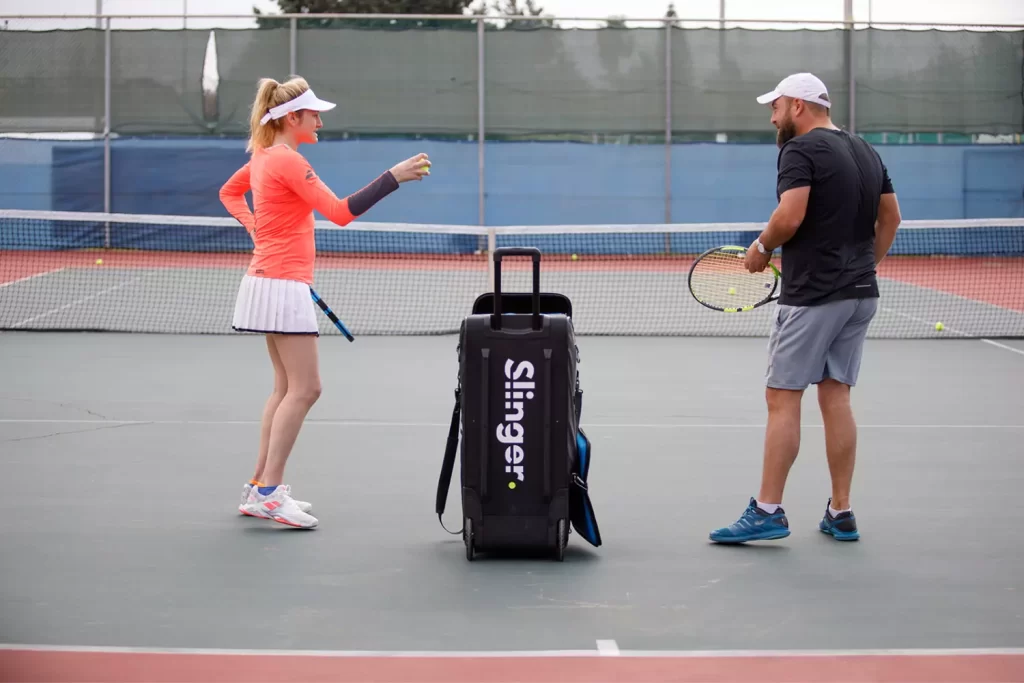
You should keep a few things in mind when choosing and purchasing a tennis ball machine, even though it isn’t rocket science.
Price & Budget
Prices range from $300 to nearly $9,000 based on 38 tennis ball machines.
Machines cost around $2,000 on average, and $1,700 is the median price between the lowest and highest.
For a quality tennis ball machine and the balls that go with it, you can expect to spend between $600 and $2,500. It is therefore helpful to create a budget you can live with, as this will narrow down your options significantly.
Frequency of Use
Your ball machine will be worth more if you use it more often, so the higher the cost, the higher the justification for the additional expense. To paint a picture, here’s an example.
Once Per Week
| Machine Cost | $2,000 |
| Cost/Use 1st Year | $38.46 |
| Cost/Use 2nd Year | $19.23 |
| Cost/Use 3rd Year | $12.82 |
Three Times Per Week
| Machine Cost | $2,000 |
| Cost/Use 1st Year | $12.82 |
| Cost/Use 2nd Year | $6.41 |
| Cost/Use 3rd Year | $4.27 |
Five Times Per Week
| Machine Cost | $2,000 |
| Cost/Use 1st Year | $7.69 |
| Cost/Use 2nd Year | $3.85 |
| Cost/Use 3rd Year | $2.56 |
In spite of the fact that it’s entirely hypothetical, it’s a helpful tool for estimating the value you’ll get from a machine based on its expected use. The amount they plan to use the machine may lead some players to reduce their budget based on these numbers.
Some people may prefer in-person lessons over online lessons. I recommend walking through this exercise regardless.
Skill level
Tennis ball machines are available in a wider variety of models if you are a beginner rather than an experienced player with more demanding requirements.
Skill-level-dependent features include:
- Ball Speed: New players will benefit from a machine with a top speed of 40 mph (64 kph). Most top out at around 80 mph (129 km/h), so a more advanced player may long for faster speeds.
- Ball Capacity: For a beginner who may tire quickly, a machine with 40 balls may be adequate, while an advanced player might prefer one with more.
- Spin: Some machines add topspin or backspin while others do not. It is likely that a higher level player will be most interested in the spin settings because those will make hitting feel more realistic.
- Oscillation: For intermediate to advanced players, the ability to oscillate or move shallowly and deeply while delivering balls is a welcome feature.
- Drills: To improve the simulation of live gameplay, drills can provide more variety. For beginners, this level of sophistication is usually not necessary early on.
It is possible that a new player will favor many features that skew towards experienced players so that they can become more familiar with the machine over time.
You can also read Best Sunglasses For Tennis
Portability & Conveineince
Portability is a top concern for people without tennis courts at home, so there are two things to consider.
Size
It will be easier to move a smaller machine, which is a big plus. As a bonus, you can easily toss it into your car.
The size of some ball machines can be reduced during travel by collapsible components.
Weight
The machine would be considered portable for most players if it didn’t exceed 50 lbs, which would be pushing it. Loading or unloading your ball machine should not strain your muscles.
It is possible to find battery-operated ball machines with internal batteries or external batteries. By lifting externally, you will lose around 10-15 lbs or about 5-6kg.
Having a machine that weighs 35-45 lbs (16-20 kg) is ideal, but too light can move when firing balls at higher speeds.
Power
Batteries or direct electricity are used to power ball machines. Obviously, you’ll have to opt for a battery-operated machine if you want a portable machine.
Sound
The amount of noise that a ball machine makes during operation is somewhat underrated.
In the absence of a private court or someone playing nearby, the noise level of the machine is important to consider.
Ease of Use
There is a learning curve associated with most ball machines, but some have more manual adjustments, which are annoying to make every time you want to hit a different shot.
While some have memory features that remember your settings so you won’t have to adjust them every time you use the machine, remote controls can save you time from constantly adjusting the machine.
Easy-to-use machines are more likely to be used over the long run, so it’s worth considering.
You can also read What Does Hindrance Mean In Tennis?
Famous Tennis Ball Machine Brands
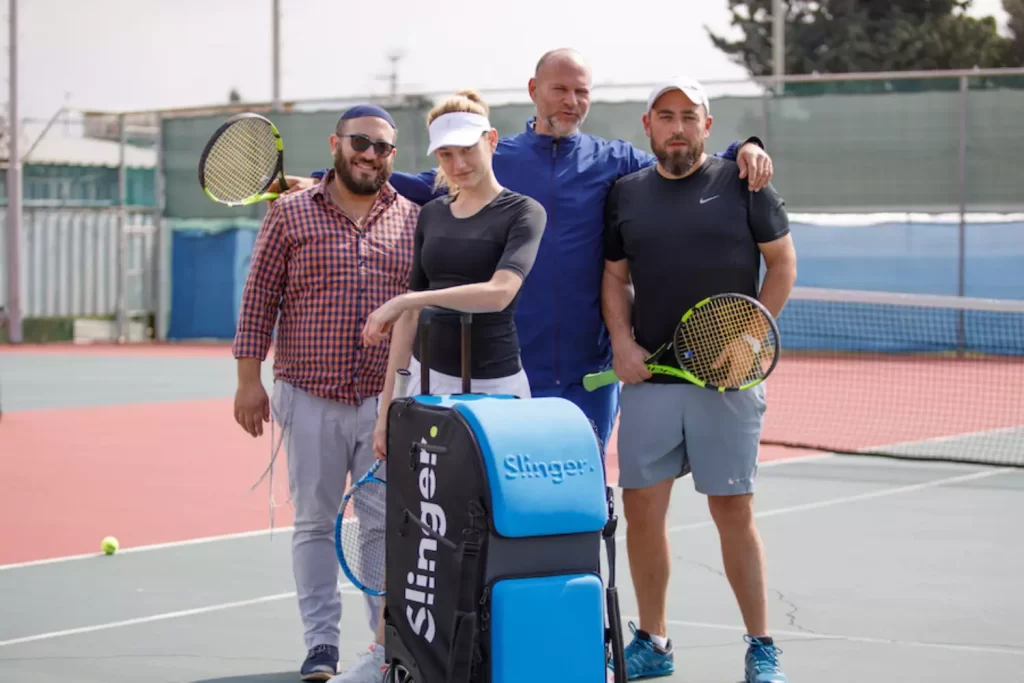
The following list represents the most reputable tennis ball machine brands on the market, but it isn’t exhaustive.
Spinfire
Two excellent portable ball machines are available from Spinfire at a mid-range price point around $2,000.
You should consider them if you’re considering a great product. They’re a trustworthy brand that makes great products.
I appreciate Spinfire’s simplicity of choices, even if you could fault the limited selection. There are two models of the same product:
| Spinfire Machine | Portable |
| Pro 1 | Yes |
| Pro 2 | Yes |
They offer the most stylish machine I have seen, even though the design isn’t particularly important.
Lobster
Lobster Sports, one of the most accessible brands, offers a variety of tennis ball machines starting at just over $1,000 and going as high as over $3,000.
In general, the company’s portable battery-powered machines are the most popular with consumers. As a company, they offer the following models:
| Lobster Machine | Portable |
| Elite Freedom | Yes |
| Elite Liberty | Yes |
| Elite One | Yes |
| Elite Two | Yes |
| Elite Three | Yes |
| Elite Grand Four | Yes |
| Elite Grand Five | Yes |
| Elite Grand 5 LE | Yes |
| Phenom | No |
| Phenom 2 | No |
They only offer a portable ball machine, the Phenom.
Founded in 1970 by Harry Giuditta, Lobster Sports is based in the US and specializes in ball machines.
Sports Tutor
Sports Tutor, based in Burbank, CA, is another popular tennis ball machine company. Their prices range from $700 to $3,200 for ten ball machines, including one for Wilson.
They offer the following machines:
| Sports Tutor Machine | Portable |
| Twist | Yes |
| eCannon | Yes |
| Tennis Cube | Yes |
| Tennis Tutor ProLite (Plus) | Yes |
| Tennis Tutor (Plus/Player) | Yes |
| Tennis Tower (Classic/Player) | No |
| Shotmaker Mini (Player/Delux) | Yes |
| Tennis Tower IO (Player/Delux) | No |
| Shotmaker (Delux) | No |
| Wilson Ball Machine | Yes |
*Parenthesis indicate options available on that machine.
There are many different sports offered by Sports Tutor, including tennis, pickleball, baseball, softball, soccer, and volleyball.
Match Mate
iSAM and Match Mate are two Staber Industries divisions that offer ball machines.
They generally have less popularity than others on our list but their machines range from $500 to $4,000. Their current ball machines are as follows:
| Match Mate & iSAM Machines | Portable |
| Rookie | Yes |
| Quickstart | Yes |
| iSAM Value (Extend, Ultimate) | Yes |
| PTS & PTS Partner | Yes, but heavier |
Machine options are listed in parentheses.
All of the company’s machines are manufactured in the US, at its headquarters in Groveport, Ohio.
Playmate
The company has made ball machines since 1973, focusing mainly on top-of-the-line machines used in tennis clubs.
Premium models start at more than $8,500, while consumer models start at $1,700. Currently, they offer the following ball machines:
| Machine | Portable |
| Half Volley | Yes |
| Volley | Yes |
| Ace | No |
| iSmash | No |
| Grand Slam | No |
Spinshot
Another US-based company that offers a range of portable tennis ball machines to suit players of all levels and styles, Spinshot offers six portable tennis ball machines from $700 to $1900.
Spinshot sells the following ball machines:
| Spin shot Machine | Spin shot Machine |
| Lite | Yes |
| Home | Yes |
| Pro | Yes |
| Plus | Yes |
| Player | Yes |
| Plus 2 | Yes |
The selection is smaller, but the products are reliable and of high quality.
Slinger Bag
Slinger Bag isn’t just a ball machine – it’s also a bag that will hold all of your on-court essentials, as suggested by its name.
With only one machine to choose from and a reasonable price tag, Slinger offers a unique entry-level machine.
The company does offer packages or bundles with its machines, which many players will find appealing since it gives them the option of shopping at one place. Among them are:
| Slinger Packages | Portable |
| Slinger Bag | Yes |
| Grand Slam Pack | Yes |
| Grand Slam Player | Yes |
| Grand Slam Champion | Yes |
The Slinger Bag was created by Joe Kalfa and then funded through Kickstarter. Nearly 3,000 people backed it, and nearly $750k was raised.
You should check them out if you’re looking for a ball machine.
You can also read Using Forced Errors In Tennis
Conclusion
The cost of ball machines warrants careful consideration, especially since they are not for everyone.
Before buying a ball machine, I recommend renting or borrowing one. This will help you get a sense of what to expect, as well as increase your confidence in the value it offers, and ultimately spend the money to buy it.
I hope this guide will help you navigate the ball machine shopping process while offering some worthwhile options to consider.
Please post a comment below if you have any follow-up questions – I would appreciate hearing from you.
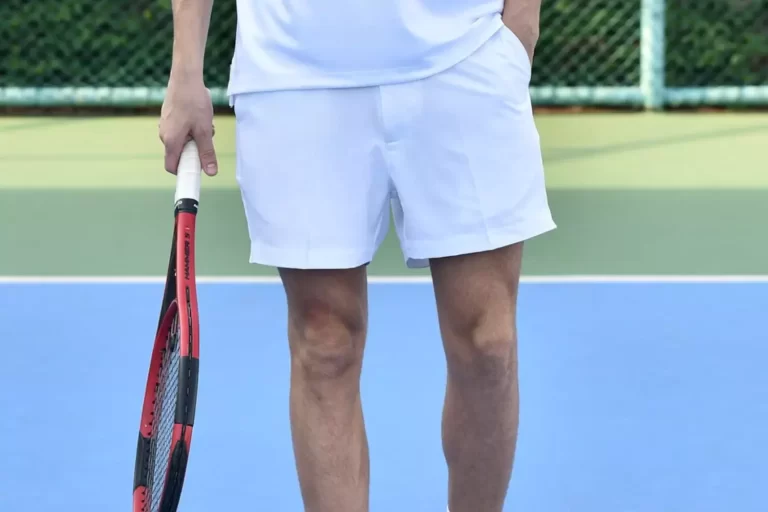
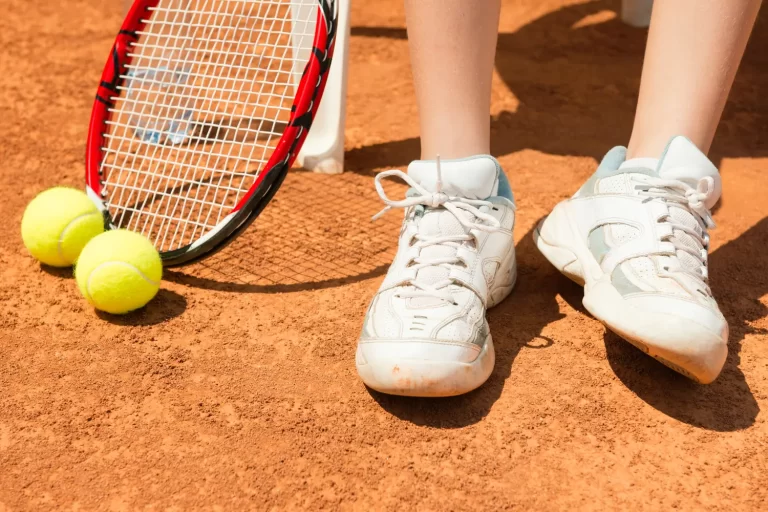
![Best Cream for Tennis Elbow 2024 [Reviews]](https://tennisracketnet.com/wp-content/uploads/2023/11/Best-Cream-For-Tennis-Elbow-768x512.webp)

